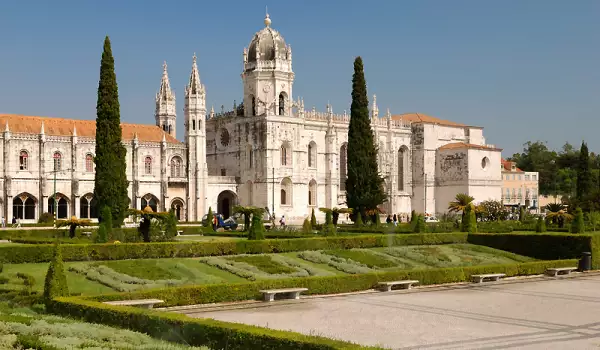Jerónimos Monastery

The Portuguese capital Lisbon is often a preferred destination for many excursionists, because of its enormous cultural and historical heritage, architectural masterpieces, beautiful temples and churches, palaces and monasteries, which seem to spring from the spirit of the past. Along with the symbol of the city - the White Tower of Belem, one of the greatest sights of Lisbon is the Jerónimos Monastery, which is the only large building to have survived the devastating earthquake there in 1775.
Jerónimos Monastery is considered one of the cultural symbols of Lisbon. It was declared by UNESCO as a monument of world heritage in 1983. Jerónimos area is located in Belem in Lisbon. The exact place is the quarter of Bairro Alto, which is known as a small neighborhood with pubs, steep streets and live performance of Fado. Here is the historic Belem Tower, whence once all Portuguese sailors on their way to the discovery of new lands ailed from, while Belem guarded the entrance to Lisbon from the river Tiju.
The Jerónimos Monastery indeed is the supreme achievement of Portuguese architecture. It is fully resolved at the local, popular in the 15th century, when Jerónimos Monastery was erected, Manuelito style, named after King Manuel I, who runs Portugal from 1495 until 1521. This architectural style is considered as the last period of Gothic architecture in Portugal. For Manuelito, as well as for Jerónimos, lavish ornaments are characteristic. Jerónimos Monastery fascinates with its rich, lavish decorations and numerous details which confuse visitors in their attempts to cover everything in sight.
Jerónimos is characterized by a complex combination with sea motifs decorated by twisted ropes, shells, waves, fish, anchors, coral, intertwined and alternating with traditional Gothic organic forms. It is believed that this style of construction in the 5th century was inspired by the great geographical discoveries that made Portugal a rich empire. The original building at the site of today's Jerónimos Monastery existed in 1450.
The impressive building, in its current form, began building by the orders of Manuel I, to mark the successful return of Vasco da Gama from India. The primary purpose of Jerónimos Monastery was to be a temple, but later became a house of prayer for seamen arriving or leaving this port.
Today the monastery tour of Jerónimos ensures visitors have an exciting adventure through history and life of seafarers. The Jerónimos Archaeological Museum is located in Lisbon and in the west wing of the monastery is located a maritime museum, which enjoys great interest from tourists from around the world.
The Maritime Museum in the Jerónimos Monastery was officially opened on July 22, 1863, and its fund is collected from the 18th century. The museum has a permanent exhibition that includes 2500 exhibits. The Museum in Jerónimos has 17, 000 exhibits - all kinds of model ships in a variety of sizes, officers’ uniforms, accessories, items used centuries ago, etc.















